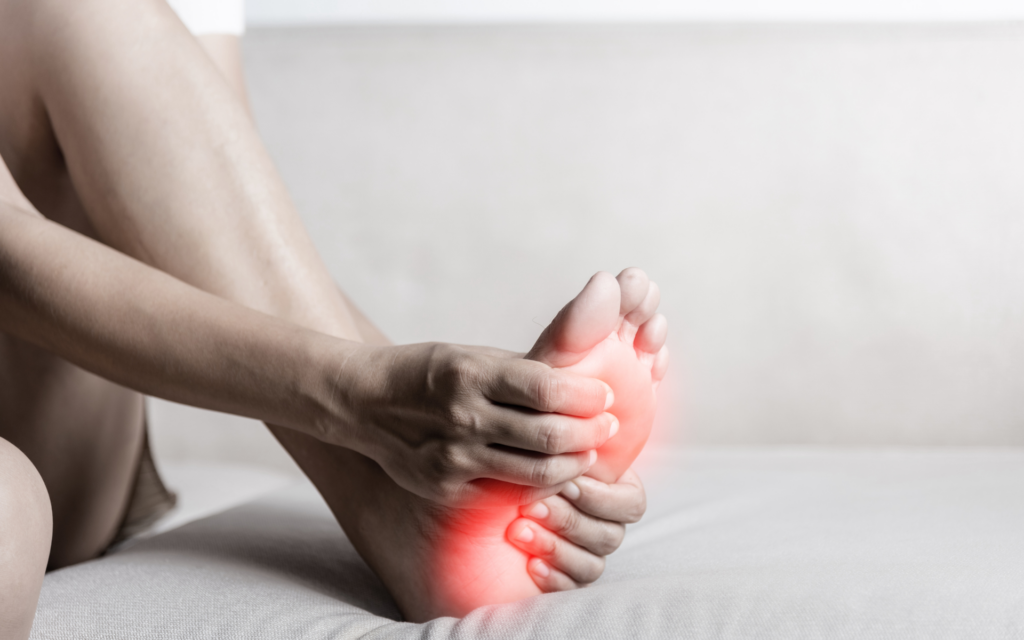Plantar fasciitis is a common yet often debilitating condition that affects the heel and arch of the foot, leading to significant discomfort and impact on daily activities. This condition, which is characterised by inflammation of the thick band of tissue that crosses the bottom of the foot, the plantar fascia, can cause chronic pain, particularly during the first few steps in the morning or after extended periods of inactivity. While professional medical treatment is crucial for severe cases, many individuals find relief through effective home treatments that address both pain and inflammation. In this post, we will explore practical and proven strategies for managing plantar fasciitis from the comfort of your home.
Understanding Plantar Fasciitis
An often occurring ailment that produces pain in the foot’s arch and heel is plantar fasciitis. The plantar fascia, a thick band of tissues that runs along the bottom of your foot, can become irritated or injured. This condition can be brought on by excessive strain on the foot, which is often the result of high-impact activities, improper footwear, or even weight gain. People with plantar fasciitis often describe their pain as sharp and localised to their heel, especially in the morning or after prolonged periods of inactivity.
The plantar fascia plays a vital role in supporting the arch of the foot and absorbing shock during walking or running. When this tissue becomes overworked or overstretched, small tears can develop, leading to inflammation and pain. Plantar fasciitis is particularly common among athletes, individuals who stand for extended periods, and those with flat feet or high arches. Though the condition can be quite painful, it is generally treatable with proper care, and many home remedies can offer significant relief without the need for surgery or invasive procedures.
Common Symptoms of Plantar Fasciitis
Plantar fasciitis presents a range of symptoms that can vary from mild discomfort to severe pain, with the most common indicator being pain in the heel or arch of the foot. This pain is often most noticeable with the first steps taken in the morning or after prolonged periods of inactivity. Individuals with plantar fasciitis frequently experience sharp pain in the heel or arch, particularly after waking up, which can significantly impact daily activities.
The discomfort associated with plantar fasciitis typically increases after standing or walking for extended periods. Stiffness in the foot, especially following inactivity, is another common symptom. Additionally, swelling or tenderness around the heel area may occur, further complicating walking and other routine activities due to the pain.
Because plantar fasciitis can sometimes be confused with other conditions such as heel spurs or tendonitis, it is crucial to carefully monitor symptoms and seek advice from a Pain Doctor if needed. Proper diagnosis and treatment are essential for effectively managing the condition and alleviating discomfort.
Home Treatments for Plantar Fasciitis
While plantar fasciitis can be painful, there are several effective home treatments that can help alleviate symptoms and promote healing. Below are some methods to manage the condition from the comfort of your home.
Rest and Ice Therapy
Ice therapy and rest are often the first steps towards effective management of plantar fasciitis. These basic therapies can aid in pain relief and inflammation reduction, laying the groundwork for additional healing.
Rest
Rest is one of the most crucial aspects of treating plantar fasciitis. Since overuse of the plantar fascia is a major cause of pain, it’s essential to reduce activities that put excessive strain on the feet. Avoid standing for long periods or engaging in high-impact activities like running. Allowing time for the tissue to heal is key to reducing inflammation and pain.
Ice Therapy
Ice packs can help numb the pain and reduce inflammation in the affected area. Several times a day, apply an ice pack or a frozen water bottle to the heel for 15 to 20 minutes. This easy-to-use yet efficient technique can help with pain relief, particularly after exertion or after spending a long day on your feet. For maximum benefits, ice therapy is frequently used in conjunction with rest.
Stretching and Strengthening Exercises
Stretching and strengthening exercises can help release tension in the tissue of the plantar fascia and surrounding muscles. These exercises aim to improve flexibility and reduce heel stress.
Standing Towel Curl
A simple yet effective exercise, the standing towel curl helps to strengthen the muscles in the foot. Place a towel on the floor and use your toes to scrunch it toward you. This exercise can be done for a few minutes each day and helps in promoting flexibility in the fascia and toes.
Calf Stretch
Plantar fasciitis can be exacerbated by tight calf muscles because they put more strain on the heel. Stretch your calves by putting one foot behind the other, standing with your back to the wall, and leaning into it to lengthen your leg. After 20 to 30 seconds, hold the stretch and then switch legs. Heel pain may be lessened by this exercise, which eases calf muscle tension.
Heel Raise
Heel raises are another great exercise for strengthening the muscles in your calves and feet. Stand with your feet hip-width apart and slowly rise onto your toes, holding for a few seconds before lowering back down. Repeating this exercise daily can help build strength in the lower leg and improve support for the plantar fascia.
Footwear Adjustments
Wearing proper footwear can make a significant difference in managing plantar fasciitis. Shoes that provide adequate support and cushioning can alleviate stress on the plantar fascia and prevent further damage.
Supportive Shoes
Select footwear featuring a firm midsole, a cushioned heel, and adequate arch support. Shoes with thin soles, flip-flops, and high heels should be avoided as they can aggravate plantar fasciitis. Purchasing well-made shoes with an emphasis on foot health can significantly aid in daily alleviation.
Weight Management and Activity Modification
Excess weight can increase strain on the feet, making plantar fasciitis worse. Modifying certain activities can also help prevent the condition from progressing.
Maintain a Healthy Weight
Carrying extra weight puts additional pressure on the plantar fascia, worsening pain and inflammation. Maintaining a healthy weight through a balanced diet and regular exercise can help reduce stress on the feet and improve overall health. If you’re overweight, losing even a small amount of weight can make a noticeable difference in your symptoms.
Modify Activities
If you’re experiencing plantar fasciitis pain, it’s essential to modify your daily activities to avoid further aggravation. Try low-impact exercises like swimming, cycling, or using an elliptical machine. These activities provide cardiovascular benefits without putting excessive pressure on the feet. Limiting high-impact activities like running and jumping can allow the plantar fascia to heal faster.
Minimally Invasive Treatments for Persistent Plantar Fasciitis
If home treatments do not provide sufficient relief, there are minimally invasive medical treatments that may be considered for persistent plantar fasciitis.
Coreflex Injections
Coreflex injections, which consist of local anaesthetic, anti-inflammatory and muscle relaxants, are a common treatment for persistent plantar fasciitis. These injections work by delivering medication directly into the affected area of the plantar fascia. The local anesthetic provides immediate pain relief, while the anti-inflammatory agents help reduce swelling and inflammation. Muscle relaxants can alleviate tension in the surrounding muscles, further easing discomfort. By targeting the source of the pain and inflammation, Coreflex injections offer effective relief and can improve mobility and function in the affected foot.
Platelet-rich Plasma (PRP) Injections
Using the patient’s own blood, PRP injections help the plantar fascia heal. The process begins with a simple blood draw, which is then spun in a centrifuge to separate and concentrate the platelets and growth factors. This concentrated PRP is then injected directly into the inflamed area of the plantar fascia. The high concentration of platelets and growth factors in PRP promotes the body’s natural healing processes and accelerates the repair of the damaged tissue.
Minimally invasive treatments provide a focused approach to managing plantar fasciitis, offering significant relief and improved function, especially when traditional methods fail. They generally involve less risk and a faster recovery compared to more invasive procedures, targeting the affected area with minimal disruption to surrounding tissues. If persistent heel pain is a concern, discussing these options with a Pain Doctor could help you find effective relief and improve your quality of life.
When to See a Doctor?
Professional medical care is necessary if:
- Severe pain that interferes with your daily activities
- Swelling or bruising around the heel or arch
- Inability to bear weight on the affected foot
- No improvement after several weeks of treatment
A Pain Doctor can evaluate your condition and recommend further treatments such as physical therapy, orthotics, or, in severe cases, surgery. Combining home treatments with professional care often provides the best results for managing plantar fasciitis and resuming normal activities pain-free.
Conclusion
Plantar fasciitis can be a painful and frustrating condition, but with the right home treatments, relief is possible. Rest, ice therapy, and targeted stretching exercises are all effective methods for reducing inflammation and promoting healing. Wearing supportive shoes and managing your weight can also alleviate the strain on your plantar fascia. While home remedies can often resolve the condition, persistent pain may require minimally invasive treatments such as corticosteroid or PRP injections. However, if symptoms continue or worsen, it’s important to consult with a doctor to explore further treatment options. By taking proactive steps and making adjustments to your daily routine, you can reduce the impact of plantar fasciitis and improve your overall foot health, regaining comfort and mobility.









